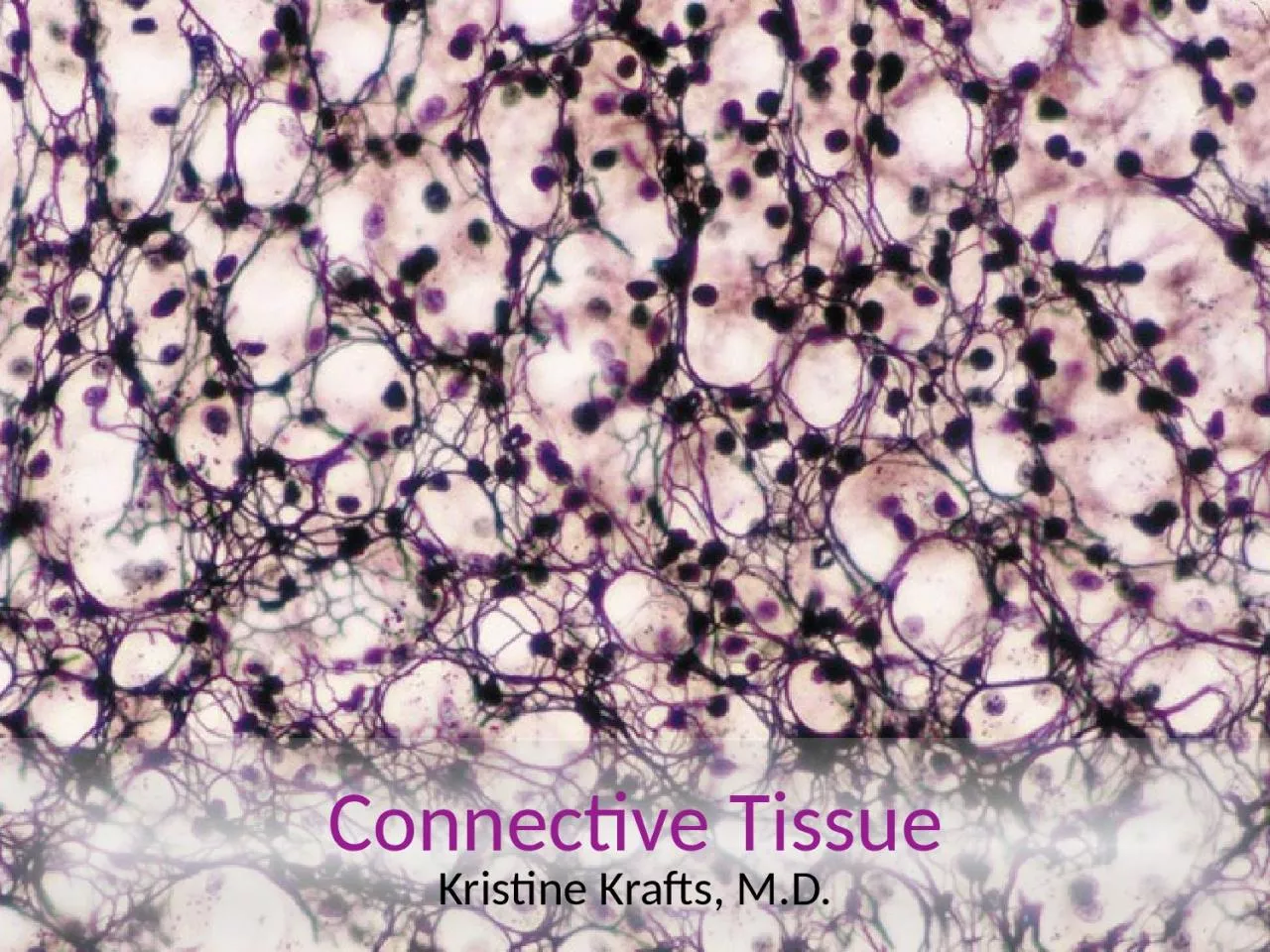

Connective Tissue Lecture Objectives List the functions of connective tissue Describe the structure function and appearance of collagen types I II and III and elastic fibers Explain what ground substance is and what it looks like ID: 1044310
Download Presentation The PPT/PDF document "Connective Tissue Kristine Krafts, M.D." is the property of its rightful owner. Permission is granted to download and print the materials on this web site for personal, non-commercial use only, and to display it on your personal computer provided you do not modify the materials and that you retain all copyright notices contained in the materials. By downloading content from our website, you accept the terms of this agreement.
1. Connective TissueKristine Krafts, M.D.
2. Connective Tissue Lecture ObjectivesList the functions of connective tissue. Describe the structure, function, and appearance of collagen (types I, II, and III) and elastic fibers.Explain what ground substance is and what it looks like.Compare and contrast the structure of glycosaminoglycans, proteoglycans, and glycoproteins.List the four types of connective tissue proper, describe what each looks like, and explain how and where each is used in the body.
3. Connective Tissue Lecture OutlineIntroductionExtracellular matrix of connective tissueCells of connective tissueClassification and examples of connective tissue
4. Connective Tissue Lecture OutlineIntroduction
5. There are ONLY FOUR basic tissues!Epithelium Connective tissueMuscle NerveAll tissues are composed of: Cells Extracellular matrix (stuff between cells)Tissue Basic Concepts
6. Extracellular matrix (ECM) is the major component of most types of connective tissue.Cells are a minor component.The other basic tissues (epithelium, muscle, nerve) are fundamentally different in that they are composed mainly of cells. What Makes Connective Tissue Unique?
7. Types of connective tissueConnective TissueConnective Tissue ProperSpecialized Connective TissueSupporting Connective TissueAdipose tissueHematopoietic tissueLymphoid tissueCartilageBoneSurrounds delicate things like vessels Scaffolds mushy things like lymph nodes Connects bonesSupports skin
8. Connective Tissue DevelopmentConnective tissue develops from a precursor tissue called mesenchyme (which arises from mesoderm). Mesenchyme is an undifferentiated tissue present only in early embryonic life. Mesenchyme gives rise to all connective tissues plus vessels and smooth muscle cells.
9. Mesenchyme: bland cells in lots of ground substance
10. Connective Tissue Lecture OutlineIntroductionExtracellular matrix of connective tissue
11. Protein fibersCollagen fibersElastic fibersGround substanceGlycosaminoglycansProteoglycansGlycoproteins Composition of Extracellular Matrix (ECM)
12. Collagen fibersFlexible, non-extensibleOver 20 types! Made of polypeptide chainsElastic fibers Thinner than collagen, and stretchierMade of elastin and fibrillinTwo Main Protein Fibers in ECM
13. TypeMicroscopic AppearanceMain FunctionMain LocationsIThick fibers and bundlesResistance to tensionSkin, tendons, bone, organ capsulesIIThin fibrils (very hard to see)Resistance to pressureCartilageIIIAlso called reticular fibers. Need silver stain to see.Delicate, flexible structural supportLymph nodes, spleen, bone marrow, basement membraneIVInvisibleSupport, filtrationBasement membraneVIIInvisibleSupportBasement membraneMain Types of Collagen in the Body
14. TypeMicroscopic AppearanceMain FunctionMain LocationsIThick fibers and bundlesResistance to tensionSkin, tendons, bone, organ capsulesIIThin fibrils (very hard to see)Resistance to pressureCartilageIIIAlso called reticular fibers. Need silver stain to see.Delicate, flexible structural supportLymph nodes, spleen, bone marrow, basement membraneIVInvisibleSupport, filtrationBasement membraneVIIInvisibleSupportBasement membraneMain Types of Collagen in the Body“Fibrillar” collagen
15. Structure of fibrillar collagencollagenmoleculescollagen fibrilcollagen fiberBundle of collagen fibers
16. Collagen fibrils, longitudinal and in cross-section, by EM
17. Type I collagen fibers and bundles
18. Type III collagen (reticular) fibers stained with silver.
19. Elastic fibers are composed of an elastin coresurrounded by microfibrils (composed of fibrillin)Structure of elastic fibers
20. Elastin can expand and contract.
21. Elastic fibers
22. Ground substanceA viscous gel that fills spaces between cells and fibers in connective tissue.Functions: binds water, fills space, acts as a barrier to infection, binds fibers and anchors cells to ECM.Not well seen in histologic sections (looks clear).Main constituents: glycosaminoglycans, proteoglycans, glycoproteins.
23. All the other GAGs (e.g., chondroitin sulfate)Shorter, and always bound to a core protein.Hyaluronic acidGlycosaminoglycans (GAGs) are just chains of disaccharides (one plain sugar + one amino sugar). There are two kinds of GAGs:Examples only! Don’t memorize.REALLY long, doesn’t need a core protein.N-acetylglucosamineN-acetylgalactosamineXyloseGalactoseGlucuronic acid
24.
25. Restylane RefyneRestylane Defyne
26. Proteoglycans consist of a protein core with a bunch of attached GAGs. They contain more carbohydrate than protein..Glycoproteins are globular proteins with attached carbohydrates. They contain more protein than carbohydrate.
27. FibronectinPresent throughout connective tissueMediates normal cell adhesion and migrationLamininPresent in basal lamina Helps epithelial cells stick to basal laminaAlso important in cell differentiation and migrationA Couple Important Glycoproteins
28. Connective Tissue Lecture OutlineIntroductionExtracellular matrix of connective tissueCells of connective tissue
29. Fibroblasts are the most common cell in connective tissue. Super active: make collagen, elastin, ground substance.FibroblastsSpindle-shaped (long, with tapered ends) and kind of boring
30. Connective Tissue Lecture OutlineIntroductionExtracellular matrix of connective tissueCells of connective tissueClassification and examples of connective tissue
31. Classification of connective tissueConnective TissueConnective Tissue ProperSpecialized Connective TissueSupporting Connective TissueAdipose tissueHematopoietic tissueLymphoid tissueCartilageBoneLooseDenseAreolarReticularRegularIrregular
32. Loose connective tissue provides delicate supportDense connective tissue resists stretching forcesEpitheliumConnective Tissue Proper in a Nutshell
33. The Four Types of Connective Tissue ProperTypeMicroscopic AppearanceMain FunctionMain LocationsDense regularThick, pink collagen bundles all parallel to each other.Resists stretching forces in one direction.Tendons, ligamentsDense irregularThick, pink collagen bundles running in different directions.Resists stretching forces in multiple directions.Dermis, organ capsulesLoose areolarLots of ground substance with scattered cells and thin fibers. Provides delicate support and cushioning.Under epithelium, around blood vesselsLoose reticularDelicate network of fine type III collagen (reticular) fibers.Provides a flexible structural framework.Lymph nodes, spleen, bone marrow
34. Dense regular connective tissueBundles of collagenFibroblastGround substance
35. Dense irregular connective tissueBundles of collagenFibroblastGround substance
36. Ground substanceSimple columnar epitheliumDelicate collagen fiberFibroblastGoblet cellLoose areolar connective tissue
37. Loose reticular connective tissueType III collagen (reticular) fibersGround substance